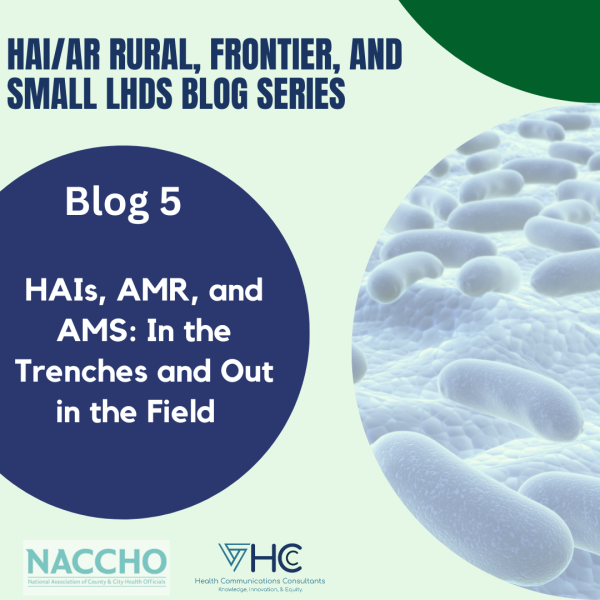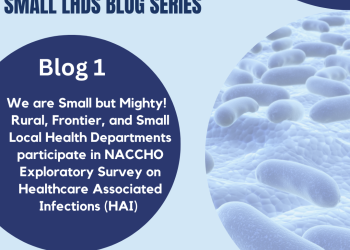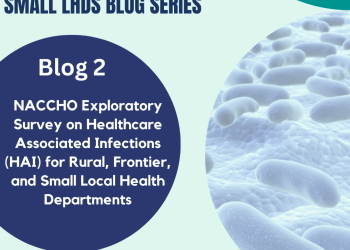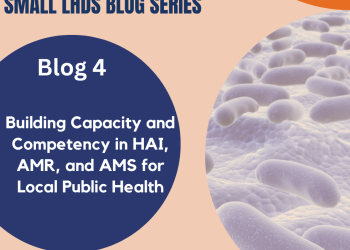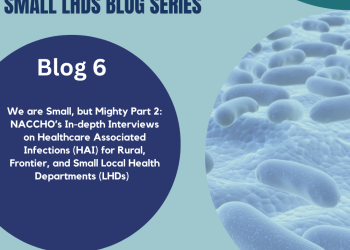From hand washing education to infection control best practices to surveillance, Public Health professionals work “in the trenches and out in the field” to prevent and control HAIs and AMR and set up AMS plans.
Why is it important to address HAIs and AMR at the local level?
A collaborative approach with LHDs and their community healthcare providers results in a public health impact of reduced HAIs and AMR which saves lives and healthcare costs each year. Rural, Frontier, and Smalls LHDs work to detect and respond to HAI outbreaks, prevent infections, stop the spread of bacteria between patients, and improve antibiotic use when addressing HAIs, AMR, and AMS.
LHD involvement in the prevention and control of HAIs is necessary because LHDs serve as the frontline of public health. LHDs have the knowledge of the local culture and have developed positive, working partnerships with their healthcare community. As such, LHDs are positioned to educate healthcare facilities about HAIs, work collaboratively with partners to break the disease cycle of HAIs, and respond to the health needs of their communities.
What can LHDs do about HAIs and AMR in their community?
LHDs can address HAIs and AMR by providing information and resources about infection prevention measures, coordinate, leverage, and implement local, regional, and state HAI prevention and response efforts, and participate in training and exercises for local HAI response and recovery. CDC’s Project Firstline provides infection control training for both frontline healthcare and public health personnel.
To strengthen LHDs’ capacity to respond to, control, and prevent HAIs and AMR across healthcare settings and in their community, CDC provides a framework of strategic goals and objectives to help LHDs and their partners to enhance coordination and promote local public health, healthcare, and community partner networks.
CDC provides the LHD HAI/AR Strategy Action Planning Worksheet Template or a planning and tracking list of HAI prioritized goals, objectives, and activities, and a Guide for Facilitating Conversations with the State HAI/AR programs for engaging with state HAI programs and other partners within the LHD healthcare community. There are three goals within the LHD HAI/AR strategy.
- Goal 1: Grow Networks and Collaboration
- Goal 2: Build Operational Capacity
- Goal 3: Expand Programmatic Activities
Conduct a Self-Assessment for LHD Capacity to Engage in HAI, AMR, and AMS Activities.
The CDC HAI/AR framework advises on three levels of activities depending on the LHD’s capacity.
- Level 1 activities form the foundational components for each objective and may be more suited for LHDs with little to no experience leading HAI/AR activities.
- Level 2 activities build upon level 1 and may be more suited for LHDs with previous experience leading HAI/AR activities.
- Level 3 activities build upon levels 1 and 2 and may be more suited for LHDs with extensive experience leading HAI/AR activities.
Rural, Frontier, and Small LHDs can utilize this framework, and its associated self-assessment, to develop Action Plans to address HAIs and AMR. Involving healthcare partners and community providers in the Action Planning process builds a collaborative and integrated approach to addressing, implementing, and evaluating successes and barriers. CDC’s Interim Local Health Department Strategy for Response, Control, and Prevention of Healthcare Associated Infections (HAI) and Antibiotic Resistance (AR) provides tools, strategies, worksheets, and guides for facilitating the planning and coordination of HAI and AMR activities at the local level.
Start the Process to Address HAIs and AMR in Rural, Frontier, and Small LHDs
Rural, Frontier, and Small LHDs play a critical role in implementing HAI and AMR prevention and response efforts. CDC’s Local Health Department Strategy is designed for LHDs to work with partners to increase capacity for HAI and AMR activities. The strategy includes a series of recommended goals, objectives, and activities based on an assessment of the key roles that LHDs could play in response, control, and prevention.
The first step is to start with an understanding of the state and local priorities, roles, and responsibilities. The next step is to start the conversation with state, regional, and local healthcare partners and community health leaders to inform which activities to embark upon first. Following the Local Health Department Strategy, Rural, Frontier, and Small LHDs can determine which activities are appropriate for their LHD, communicate with colleagues at the state and/or regional HAI and AMR program, develop a strategic plan for implementation.
Connect to Antimicrobial Stewardship (AMS) Programs
Antibiotic stewardship (AMS) refers to efforts in doctors’ offices, hospitals, long-term care facilities, and other healthcare settings to ensure that antibiotics are used only when necessary and appropriate. Initiatives dedicated to improving antibiotic use are commonly referred to as AMS programs. Proper usage helps to slow the emergence of resistance. CDC’s Antimicrobial Use and Resistance Options provides protocols, data validation resources, and other supporting materials for AMS programs. The Infectious Disease Society of America (IDSA) offers policy and procedure templates and other resources for AMS programs. The Association for Professionals in Infection Control Epidemiology (APIC) Text provides up-to-date references for infection prevention and control, guidelines, regulations, and standards of practice for AMS.
